Cohesin ATPase activities regulate DNA binding and coiled-coil configuration
- PMID: 35939705
- PMCID: PMC9388089
- DOI: 10.1073/pnas.2208004119
Cohesin ATPase activities regulate DNA binding and coiled-coil configuration
Abstract
The cohesin complex is required for sister chromatid cohesion and genome compaction. Cohesin coiled coils (CCs) can fold at break sites near midpoints to bring head and hinge domains, located at opposite ends of coiled coils, into proximity. Whether ATPase activities in the head play a role in this conformational change is yet to be known. Here, we dissected functions of cohesin ATPase activities in cohesin dynamics in Schizosaccharomyces pombe. Isolation and characterization of cohesin ATPase temperature-sensitive (ts) mutants indicate that both ATPase domains are required for proper chromosome segregation. Unbiased screening of spontaneous suppressor mutations rescuing the temperature lethality of cohesin ATPase mutants identified several suppressor hotspots in cohesin that located outside of ATPase domains. Then, we performed comprehensive saturation mutagenesis targeted to these suppressor hotspots. Large numbers of the identified suppressor mutations indicated several different ways to compensate for the ATPase mutants: 1) Substitutions to amino acids with smaller side chains in coiled coils at break sites around midpoints may enable folding and extension of coiled coils more easily; 2) substitutions to arginine in the DNA binding region of the head may enhance DNA binding; or 3) substitutions to hydrophobic amino acids in coiled coils, connecting the head and interacting with other subunits, may alter conformation of coiled coils close to the head. These results reflect serial structural changes in cohesin driven by its ATPase activities potentially for packaging DNAs.
Keywords: ATPase; DNA binding; cohesin; coiled coil; suppressor screen.
Conflict of interest statement
The authors declare no competing interest.
Figures
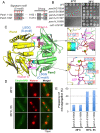
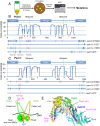
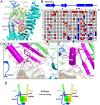
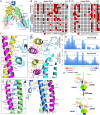
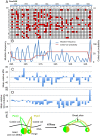
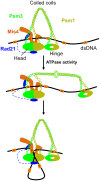
Similar articles
-
Site-to-site mutational dissection of fission yeast cohesin reveals its dynamics.G3 (Bethesda). 2025 Jul 9;15(7):jkaf111. doi: 10.1093/g3journal/jkaf111. G3 (Bethesda). 2025. PMID: 40388360 Free PMC article.
-
Suppressor screening reveals common kleisin-hinge interaction in condensin and cohesin, but different modes of regulation.Proc Natl Acad Sci U S A. 2019 May 28;116(22):10889-10898. doi: 10.1073/pnas.1902699116. Epub 2019 May 9. Proc Natl Acad Sci U S A. 2019. PMID: 31072933 Free PMC article.
-
Suppressor mutation analysis combined with 3D modeling explains cohesin's capacity to hold and release DNA.Proc Natl Acad Sci U S A. 2018 May 22;115(21):E4833-E4842. doi: 10.1073/pnas.1803564115. Epub 2018 May 7. Proc Natl Acad Sci U S A. 2018. PMID: 29735656 Free PMC article.
-
The torments of the cohesin ring.Nucleus. 2017 May 4;8(3):261-267. doi: 10.1080/19491034.2017.1295200. Epub 2017 Feb 27. Nucleus. 2017. PMID: 28453390 Free PMC article. Review.
-
Cohesinopathies, gene expression, and chromatin organization.J Cell Biol. 2010 Apr 19;189(2):201-10. doi: 10.1083/jcb.200912129. J Cell Biol. 2010. PMID: 20404106 Free PMC article. Review.
Cited by
-
Site-to-site mutational dissection of fission yeast cohesin reveals its dynamics.G3 (Bethesda). 2025 Jul 9;15(7):jkaf111. doi: 10.1093/g3journal/jkaf111. G3 (Bethesda). 2025. PMID: 40388360 Free PMC article.
-
Structural biology of SMC complexes across the tree of life.Curr Opin Struct Biol. 2023 Jun;80:102598. doi: 10.1016/j.sbi.2023.102598. Epub 2023 Apr 25. Curr Opin Struct Biol. 2023. PMID: 37104976 Free PMC article. Review.
-
Convergent pairs of highly transcribed genes restrict chromatin looping in Dictyostelium discoideum.Nucleic Acids Res. 2025 Jan 11;53(2):gkaf006. doi: 10.1093/nar/gkaf006. Nucleic Acids Res. 2025. PMID: 39844457 Free PMC article.
-
Cohesin organization, dynamics, and subdomain functions revealed by genetic suppressor screening.Proc Jpn Acad Ser B Phys Biol Sci. 2023;99(3):61-74. doi: 10.2183/pjab.99.005. Proc Jpn Acad Ser B Phys Biol Sci. 2023. PMID: 36908173 Free PMC article.
-
Improved cohesin HiChIP protocol and bioinformatic analysis for robust detection of chromatin loops and stripes.Commun Biol. 2025 Mar 14;8(1):437. doi: 10.1038/s42003-025-07847-w. Commun Biol. 2025. PMID: 40082674 Free PMC article.
References
-
- Uhlmann F., SMC complexes: From DNA to chromosomes. Nat. Rev. Mol. Cell Biol. 17, 399–412 (2016). - PubMed
-
- Yatskevich S., Rhodes J., Nasmyth K., Organization of chromosomal DNA by SMC complexes. Annu. Rev. Genet. 53, 445–482 (2019). - PubMed
-
- Arumugam P., et al. , ATP hydrolysis is required for cohesin’s association with chromosomes. Curr. Biol. 13, 1941–1953 (2003). - PubMed
-
- Haering C. H., Löwe J., Hochwagen A., Nasmyth K., Molecular architecture of SMC proteins and the yeast cohesin complex. Mol. Cell 9, 773–788 (2002). - PubMed
-
- Lammens A., Schele A., Hopfner K. P., Structural biochemistry of ATP-driven dimerization and DNA-stimulated activation of SMC ATPases. Curr. Biol. 14, 1778–1782 (2004). - PubMed
Publication types
MeSH terms
Substances
LinkOut - more resources
Full Text Sources

